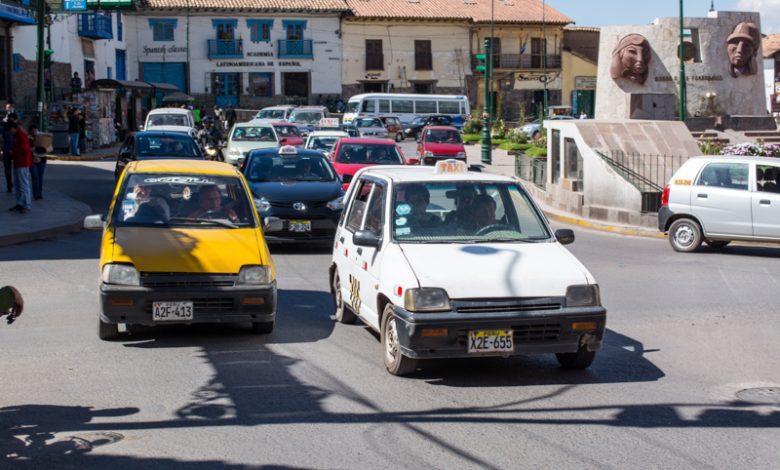Taxis, Buses, and Cars Snarl Cuzco’s Streets

Main streets often come to a crawl in Cuzco, especially when there is an event in the Plaza. Even on ordinary days the streets back up with cars, buses and trucks. The city was just not designed with so many vehicles in minds. Its colonial core was meant for foot traffic and horse carriages, though its newer streets are still too narrow for the vehicular demand.
Credit for cars became available and people who qualify have rushed to get a vehicle, not just here but throughout Peru. As a result, the city’s infrastructure is stretched. Still there are many, many people who either choose not to drive or do not have the resources to obtain loans.
As a result, the city has large numbers of taxis, formal ones registered and often associated with named agencies as well as a floating quantity of informal taxis. It also has its system of urban transport, including buses and minibuses, not to mention all the tourist buses and vans.
During peak hours it often seems traffic stands still and then moves suddenly for a few inches. This is true at eight in the morning and at six at night.
Cuzco’s public transport, its buses and combis (as the vans are called) go from the main part of town to all of its neighborhoods. During times of high demand they are completely full. People are standing and it seems you could not even add a pin to them. The young man or woman, boy or girl, who is responsible for charging fares hangs on the outside of the door since there is no room inside. They cannot get in and close the door while the vehicle is in movement.

At seven in the morning it is mostly school children who fill up the buses and combis. At one, when people go for lunch, at six pm and at nine pm the mobilidades, as we call them in Spanish, are also full. If you need to make a trip then, you must realize that you will travel squeezed into someone else and get on and off through shoving and pushing.
Because of this many people prefer to use taxis, even though they cost much more. People prefer to pay. They arrive more quickly at their destination and they can avoid the buses with their pushing and with the occasional pickpocket or mugger. The taxis will also go where one wishes, within some limits.
In contrast, the buses and combis have a fixed route.
However, when traffic stalls, both the buses and taxis come to a standstill while waiting for a chance to move forward. What normally takes a few minutes to traverse can take, ten, twenty minutes or a half hour. You have to wait for those around you to move before you can continue on your way.
As a result, many taxi drivers prefer to work nights. They start at ten pm to drive around the city’s streets hunting for passengers. Working at night, they say is more tranquil and there is much less traffic. Their main problem, besides finding passengers, is worrying about their eyes suddenly closing while driving. To not run this risk, the taxi drivers who work nights try to sleep soundly during the day to be able to carry out their routine at night.
Taxi drivers who may not have all their papers in order also may work nights because there are fewer police in the streets who might check up on them. In any case, getting between here and there is increasingly a challenge for the people of Cuzco, and its drivers.




